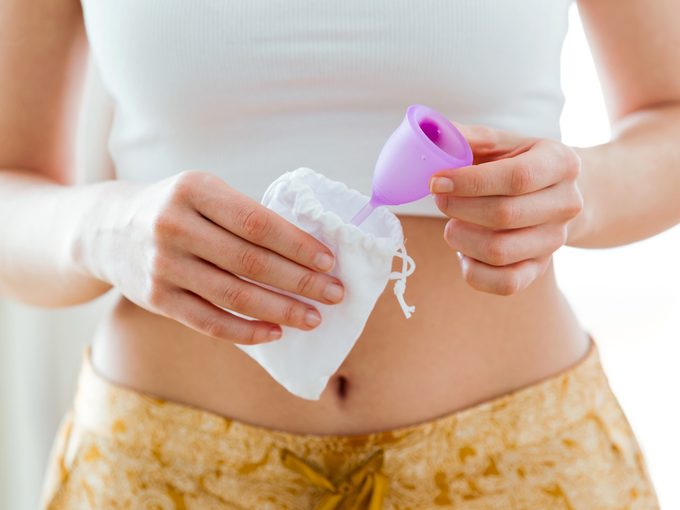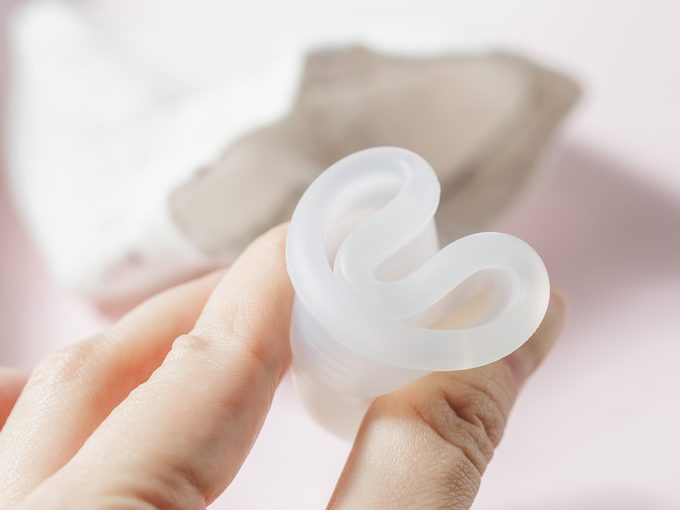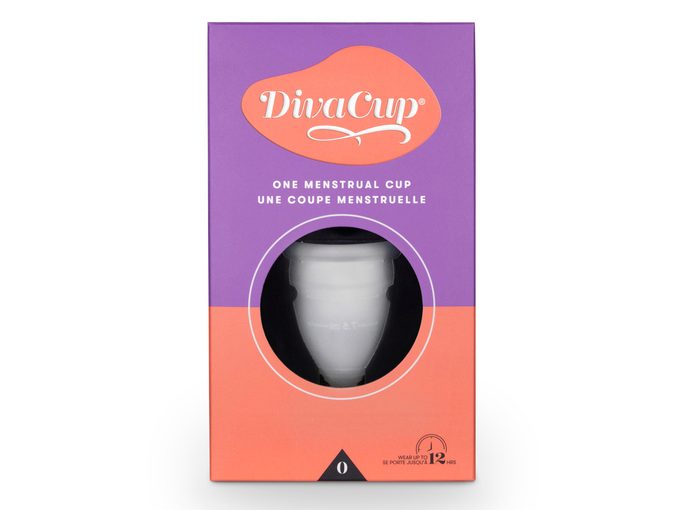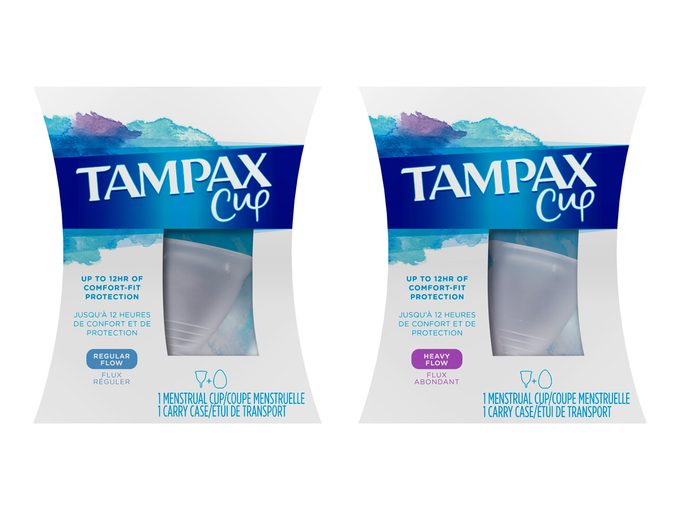Everything You Need to Know About Using a Menstrual Cup
Including how to insert and remove it.

There’s a growing group of women who actually get excited about a certain period product (and I’m not talking about period underwear). These same women who once discreetly tucked a tampon up their sleeve are now singing their praises for the menstrual cup. These menstrual cup evangelists will tell you that making the switch from pads or tampons to a cup was the best decision they’ve ever made. And they’re not wrong. I know because I am one of them. I switched to a menstrual cup (specifically, DivaCup) after my period returned following the birth of my daughter who is now two-years-old. It was the best decision, and yes, I wish I had switched to a menstrual cup sooner.
When Proctor & Gamble scientists began research for the development of its new cup, the Tampax Cup, they found out just how enthusiastic cup users can be. “If you go on Twitter or Tumblr, you find fan art for cups, which is so different from normal period products where people just don’t talk about them at all. There were like 10 times as many reviews for cups as there were for pads or tampons,” says P&G Senior Scientist and FemCare R&D, Rebecca Stoebe-Latham. “We started digging into those reviews. We very intentionally designed the cup with a few small but really noticeable differences in terms of shape and size to make the experience better.”
Want to know more? Here’s how to use a menstrual cup and what to know if you’re considering the switch from pads or tampons.
What exactly is a menstrual cup?
A menstrual cup looks like a tiny funnel or bell. It’s made of medical grade silicone and once inserted, it sits at the base of your vaginal canal where it collects menstrual blood during your period.
How do you insert it?
To insert, fold the cup into a C-shape, and relax while you’re sitting, squatting or standing with one leg raised. Holding the folded cup in one hand, use your other hand to gentle separate your outer labia. Slide the cup into your vagina, letting go so the cup returns to its natural shape inside of you. To make sure the cup has opened fully and created a suction seal, rotate your cup by pinching the bottom and turning it until it pops into place. You can also gently pull down on the stem to make sure the cup is secure.
Most menstrual cups come with step-by-step instructions and diagrams to help you with insertion and removal. You can find instructions for DivaCup here, and Tampax Cup here.

Can it get lost or stuck inside?
Lost? No. Stuck? Another no. But if you’re a new user, it might seem stuck if you aren’t sure how to remove it. Luckily there are tips for removal; see below.
How do you remove it? Better question: How do you remove it without getting blood everywhere!?
The removal process – and the mess that may occur in the process – is probably the biggest hurdle for new and prospective users. Yes, there’s a bit of a learning curve when it comes to inserting and removing your menstrual cup. But it gets easier! It just takes a bit of practice, and you will become very familiar with your internal lady parts.
Despite what you may think, the stem on the cup is not there for you to pull on it to remove. Instead you’ll want to grab the bottom of the cup and pinch it to break the suction. As you pinch it, try to fold the cup in half to remove (similar to how you inserted it).
Another tip is to take it out and re-insert your cup while you’re in the shower. You’re usually more relaxed and there’s no need to worry about making a mess.
How long can you leave it in?
12 hours. Many menstrual cup users, myself included, empty the cup once in the morning and then again in the evening before going to bed. Most cup sizes hold approximately 30 mL of blood.
How do I clean it?
After you remove your cup, rinse it with warm water and wash it with a gentle, unscented soap. Then, you’re good to re-insert. Some cup brands like DivaCup also offer a cleanser.
In between cycles, sanitize your cup using boiling water. Then store it in the case it came with until you need it again.
Is it one-size-fits-all?
No. There are several brands on the market, and each may have slight variations. Most brands also offer two or more different sizes. For example, DivaCup originally launched with two sizes. Model 1 for women under the age of 30, and Model 2 for women over the age of 30 or any women who have given birth (either vaginally or via cesarean section). The brand recently introduced a third option, Model 0, designed for youth aged 13-18.

The Tampax Cup, on the other hand, offers two sizes according to flow rather than age. “We learned through our research that the size of the vaginal canal actually correlates better with your flow than it does with age or whether or not you’ve had children. So it’s more likely that if you have a light flow you’re going to have a smaller vaginal canal,” says Stoebe-Latham. “It’s not perfect so it won’t work for everyone, but it is a better measure than age.”

Are menstrual cups better for the environment?
Yes! Consider that the average woman will use anywhere from 8,000 to 15,000 disposable pads, tampons and liners in her lifetime. That’s a lot of waste that ends up in landfills. Plus, the manufacturing processes for the cotton and plastic used in some products also takes a toll on the environment. And you know we’ve got a serious plastic problem.
How long does one menstrual cup last?
You may find anecdotes of some women using the same cup for as many as 10 years. Silicone is a durable material so it is possible, depending on how well you clean and care for your menstrual cup. Most brands recommend you purchase a new one about every year though.
How much does it cost?
Both DivaCup and Tampax Cup have a suggested retail price of $40. If you replaced your cup every year, that’s likely still less than what you would spend on pads and tampons each year. And thanks to the abolishment of the “Tampon Tax,” menstrual cups are also exempt from sales tax in Canada.
Can I use a menstrual cup if I’ve never even used tampons?
Sure. “It’s a little intimidating, especially because it’s a lot bigger than a tampon and you have to be pretty comfortable with your body, but there’s certainly no harm in starting out with one,” says Stoebe-Latham.
Can you use a menstrual cup with an IUD?
Yes, but let your doctor know you’re using one. “If you do have an IUD we recommend you tell your OBGYN because there’s a small chance that suction, or depending how you pull it out, could dislodge your IUD. It’s really rare, it’s a low chance but it is something that could happen,” says Stoebe-Latham.
Are there other alternatives?
Sure. In addition to tampons, pads and liners, there are also washable cloth pads (Lunapads is one Canadian brand), as well as leakproof underwear (from brands like Knix and Thinx). Depending on how heavy your menstrual flow is, you may find it best to combine one or two of these options. I often wear a menstrual cup with Knix leakproof underwear.
Next, learn why some women are ditching the pill in favour of birth control apps to prevent pregnancy.




